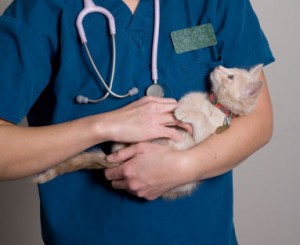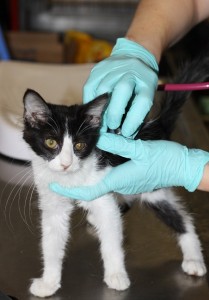The high time is upon us and it is time to go back to the basics! The importance of the physical examination of our pediatric patients (especially prior to surgery) cannot be overstated. It tells us not only the age, gender, and health status of our patients, but also alerts us to many potential surgical complications, and conditions that need to be addressed during surgery. Pediatric spay/neuter is routinely performed on patients that are between 7 and 16 weeks of age. However, patients of this age may also be presented for other surgeries as well, such as enucleation or limb amputation.
A physical exam should be conducted systematically, in a routine manner, in order to prevent omission of any of its parts and missing anything important. Equipment should minimally include a stethoscope, scale and recording material, and may also include a thermometer, otoscope or penlight. Ideally kittens should be housed with litter-mates (even in the perioperative period) to minimize stress, facilitate appropriate behavioral development and reduce chance for spread of infectious diseases to other kittens. Each kitten should be clearly identified; this can be with a collar, tag, or gender and adequate description.
The first part of a physical examination is the exam at a distance. Careful attention should be given to mentation, energy level, gait and breathing pattern. Is the kitten interested in its surroundings? Is it friendly or withdrawn? Valuable information can often be gained by observing kittens before handling them.
Ideally the examination room would be free from barking dogs and other loud noises. The kitten should be allowed to approach the examiner rather than being immediately retrieved from the cage upon opening. Remember that kittens are impressionable and that gentle, low-stress handling will positively affect their future behavior. Every kitten should be weighed with a baby scale or gram scale in order to accurately dose analgesic and anesthetic agents and to be sure their weight reflects their known or estimated age. As a general rule of thumb, kittens gain about a pound every 4 weeks. Therefore, an 8-week old kitten should weigh about 2 pounds, and a 12-week old kitten should weigh about 3 pounds and be cutting its first adult incisors.
One approach to an examination is from the head to the tail. For our purposes we will divide the examination into four parts: the head and neck, forequarters and thorax, abdomen and hindquarters.

For the head and neck be sure to carefully examine the eyes, nose and mouth as well as the skin around those areas. Look for accumulation of dried secretions in the eyelid margins and corners of the eyes. Note the color of the whites of the eyes (sclera) and pink insides of the eyelids (conjunctiva). Observe the clarity of the cornea (the clear part of the eye) and check for inflammation (redness or swelling) of the conjunctiva. Look for abnormalities such as elevation of the third eyelid or discrepancies in pupil size. Press gently on the nares and look for secretions. Check the ears for debris as well as the skin around the ears for scratches and hair loss. Open the mouth gently by grasping behind the upper canine teeth and pressing down on the lower incisors. Inspect for ulcers, mucus membrane color and for abnormalities of the tongue or soft palate. Examine the teeth for discoloration (indicating a dead tooth) or fractures. Check the capillary refill time. Palpate the neck, particularly the left side of the neck, for swelling or other evidence of esophageal disease. Palpate the mandibular lymph nodes for any abnormalities.
Examine the forequarters and thorax next. The prescapular lymph nodes should be very small or indiscernible. The forelimbs should be palpated joint by joint from the toes to the shoulder. Palpate the long bones for any pain or deformities. Note any additional toes and toenails. Palpate the ribs and spine. Listen carefully to the heart and lungs (ideally with a pediatric stethoscope). The lungs should be ausculted on both the right and left side and in all 4 lung quadrants (dividing into cranial and caudal as well as dorsal and ventral parts) for abnormal sounds or quiet zones. Carefully auscultate the heart on both the left and right sides of the chest. Keep in mind that inadvertent pressure placed on the chest while ausculting can cause an inducible murmur (through deforming the cardiac wall) in cats and kittens. Murmurs can be innocent or congenital. Innocent murmurs do not usually persist past 16-weeks of age. Palpate the femoral pulse while listening to the heart to be sure that it is strong and synchronous.
For the abdomen observe the skin and musculature. Look for evidence of parasites and umbilical herniation. Palpate the spine and abdomen gently for signs of discomfort, masses or other abnormalities. Finally, examine the hind limbs in the same manner as the forelimbs, from toes to hips. Check the perineum and anus for any evidence of fecal staining, inflammation or other abnormalities. Check the gender, and if male palpate for both testicles. A pre-operative temperature may or may not be useful. Kittens usually descend their testicles by 4 to 8 weeks of age. If both testicles are not descended by 16 weeks of age, cryptorchidism should be suspected.
A thorough physical exam just prior to surgery is an invaluable tool in finding common abnormalities seen in kittens including brewing or resolving upper respiratory infections, diarrhea, ear mites and other parasites as well as less common abnormalities such as heart murmurs, cryptorchidism, umbilical hernias and more. A gentle, systematic approach, in a quiet room just before surgery can not only help evaluate anesthetic safety but also save many potential complications including the need to re-anesthetize the patient in the future to correct things that were missed such as fractured deciduous teeth or umbilical hernias.
Adapted from Veterinary Pediatrics, Dogs and Cats from Birth to Six Months by Johnny D. Hoskins, 3rd edition, by Dr. Kara Breeding, Maddie’s(R) Shelter Medicine Intern at Cornell University.



“… physical exam should be conducted systematically, in a routine manner, in order to prevent omission of any of its parts and missing anything important …” I would imagine a check-list like those used in aviation by pilots, no matter how old and experienced, might help? I once observed a tractor technician in the field and he had a headset that actually went through each diagnostic step with him, plus, depending on how he “crossed of” each item on an electronic pad, would branch into deeper analysis and/or skip certain parts (a bit like an expert system which were all the rage in the eighties and have gone surprisingly quiet in recent years despite the technology for the first time being miniature and mature enough. And taking it a step further, logging certain findings might even lead to a database that contains data for research and data mining, thus leading to ever finer tuned evidence-based diagnostic patterns. As for spaying or neutering “… between 7 and 16 weeks of age …” – there is a discussion in Europe about whether it would not be better to wait until adulthood?
Hi Maureen — Thanks for your insightful comments. In regards to the checklists, yes, many of our protocols and “fail-safes” in shelter med and spay neuter parallel those of pilots, and human doctors. If you have not already read it, I suggest Atul Gawande’s Checklist Manifesto; really great read from a human surgeon about this very principle. In regards to early age spay-neuter, this is obviously an area of hot debate in our own country, as well as parts of Europe. Early research in the US indicates it is not only safe for individual animals (in the short and the long term), but likely very effective in decreasing overpopulation of our companion species when targeted to specific areas and populations. If you talk to our colleagues in many European countries, they do not have problems with pet overpopulation in their communities due to very different approaches to companion animal containment and breeding. However, they do have higher rates of pyometra, dystocia, and other complications that come with being intact. Early age spay neuter of homeless and free-roaming companion animals is critical in the US where pet overpopulation and shelter euthanasia are still the tragic reality.
Thanks again for such great comments, and for being a reader. We love the hear from you.